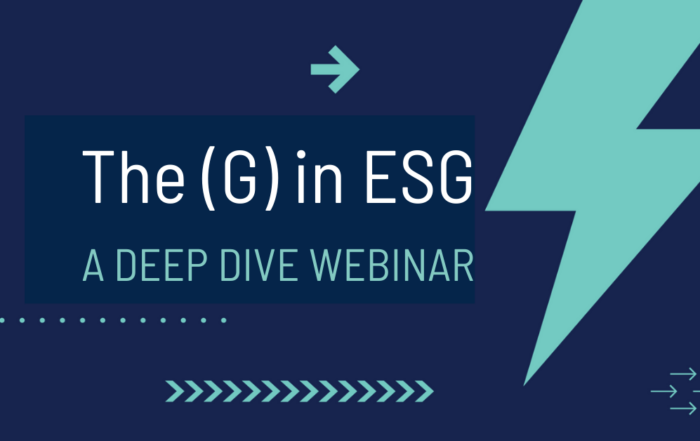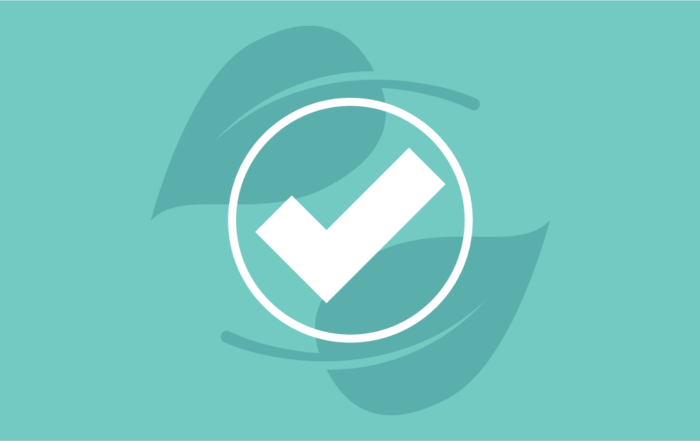What to Know About Your Future ESG Program
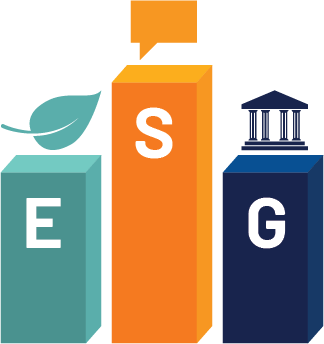
The path to a successful ESG program still seems unclear for those responsible for its development. To get an accurate read on the rising state of environmental, social and governance (ESG) programs in development, we met with directors from sustainability, risk, and audit roles in organizations across investment banking, healthcare, consulting, energy, and consumer packaged goods industries to discuss what they are or are not doing to prepare for a future of ESG regulations.
In this article, we review five key insights from these conversations and examples of how you can apply them to your future ESG initiatives.
5 ESG Program Insights for Your Future
1) A domino effect is on the horizon.
While it is possible that your organization’s desire or impetus to start an ESG program is out of pure goodwill, the reality is that most businesses will initiate ESG programs because they are driven by upstream or downstream business impacts.
This is the domino effect. As more and more organizations begin adopting ESG programs, their partners will be forced to adhere to ESG policies or build their own ESG programs.
Let’s unpack an example of this using a manufacturing company that produces and sells bottled water.
This U.S.-based company not only sources its own water but also manufactures the plastic bottles that hold the water before distributing it across the globe. Customers in Europe start asking about the sustainability practices behind plastic production and the origination source of the water. The company will need to produce disclosures that document how and to what extent its practices harbor environmentally sustainable activities. Those disclosures could include documentation of the recyclable components, CO2 emissions from the manufacturing process, and even the energy amounts exerted in the transporting of water to distribution centers. Not every organization has the capability to measure their CO2 emissions, let alone provide real-time reporting on those and other metrics.
As values-based purchases take an even bigger role in the market, retailers increasingly evaluate providers—including bottle water vendors—that have and will disclose sustainability goals. If not? A company loses that customer and perhaps even more for similar reasons. An already competitive market just got even more cutthroat.
ESG is accelerating the importance of supply chains, which gives vendor managers even more to manage, worry about, and plan against. Since Europe has already enacted regulations specific to ESG, including EU Taxonomy Regulation, and the SEC has announced the creation of a task force to begin reviewing climate and ESG issues, this type of example is likely to occur frequently across all industries in the future.
2) Your reputation is at stake.
The ESG movement is as much about managing your company’s reputation as it is about managing energy usage or carbon emissions. Why? Because ESG is a value concept driven by widespread cultural change. Investors and consumers today are using their wallets to support organizations working to make a positive impact for the planet.
Today, it’s common for consumers to evaluate companies by carbon footprints as well as Glassdoor reviews before making a purchase. Your company is not just providing a good or service for them. Thanks to digital shopping and sharing habits, customer purchases define who they are and their values. Consumers now ask themselves, “Do I want people to know I shop here?” and, “Would I recommend this company to my friends?”
This is a shift in the financial conversation from stockholders to stakeholders, but that doesn’t mean losing out on financial value.
Investment bankers and asset managers are advising enterprises to consider the long-term impact of ESG, which can translate to overall increased value that will ultimately trickle down to revenue.
To see this in action, let’s look at ESG and non-ESG funds from two of the largest asset management firms.
- MSCI World ESG Leaders Fund outperformed the MSCI World Fund by 1.84%
- JPMorgan ESG EMBI Global Diversified Fund outperformed the EMBI Global Diversified Fund by 1.94%
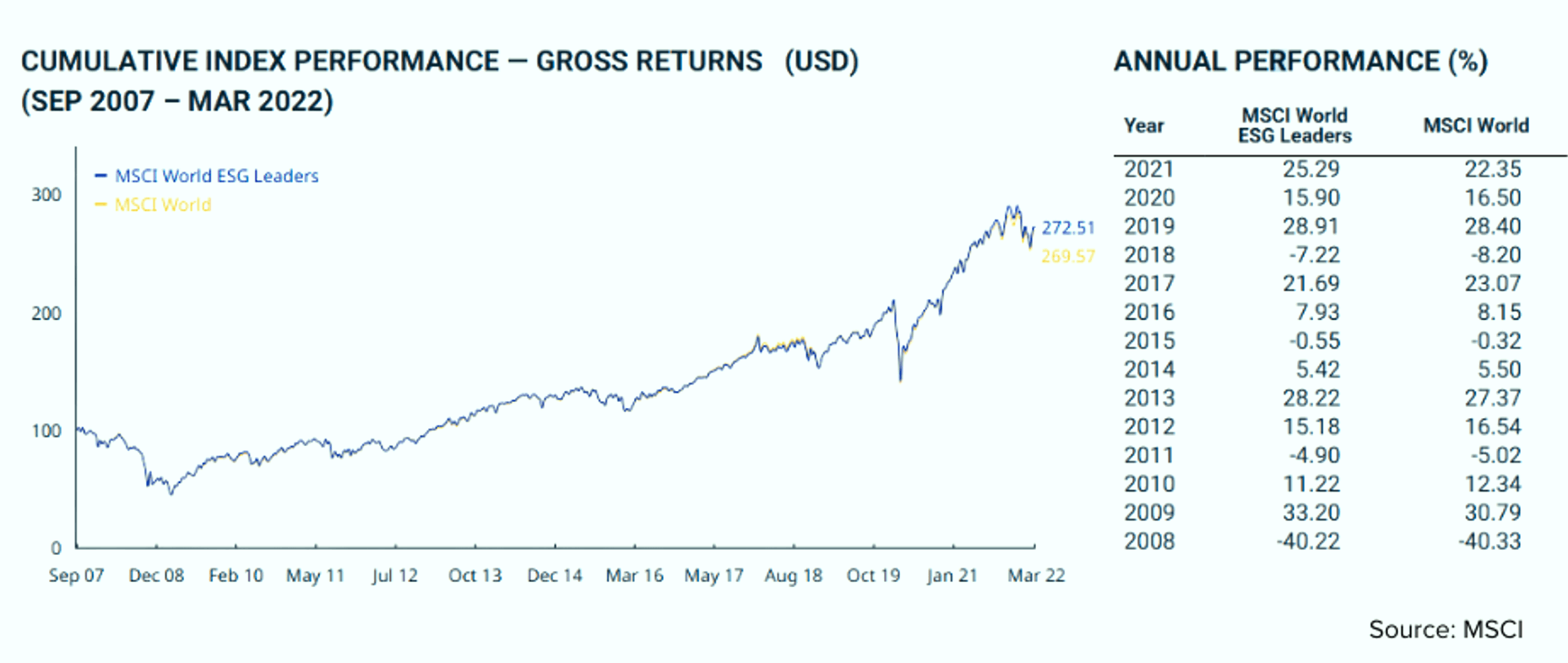
3) ESG compliance is about holistic & creative decision trees.
Unlike tenured compliance programs and long-standing regulations, ESG programs are still largely in development. End programs will be reliant on creative decision trees to solve new-to-us problems. Additionally, ESG programs will require incorporation into almost every aspect of a business. ESG will not be specific to frontline employees or specific departments, and it will include looking at environmental, social and governance approaches from both risk and opportunity perspectives.
One example that companies are currently tackling is the post-pandemic social challenge of returning employees to a physical office. The influence of health issues, the Great Resignation, and rising gas prices all factor into a company’s decision and how that communication is perceived by its employees, stakeholders, and customers.
Many companies are taking this cultural moment to rethink their approaches to the workplace, to provide both inclusivity and flexibility. Using a holistic lens, modern businesses are looking at work options empower employees to achieve their best productivity, whether that’s fully remote, fully in the office, or a hybrid. This is in sharp contrast to companies that are still mandating the number of days an employee must be in the office, which seems tone-deaf by comparison.
Optimal collaboration and productivity vary not just by department or role, but by introversion and extroversion, time of day, day of the week, and current events in an employee’s personal life.
Today, employees are looking for companies for which they can work where they believe they can make an impact, their opinions will be respected, and they feel valued. Prior to the pandemic, businesses rarely prioritized optimal work options for employees.
The takeaway is that ESG brings more business considerations to the table than simply revenue. The belief of industry analysts and the investment banking community is that effective ESG programs will enable companies to attract better talent—who bring better ideas—which enables better products and services.
4) ESG standards & frameworks are available.
While achieving compliance with future ESG regulations will require creativity, you can rely on a systematic process to formulate and monitor your approach using existing frameworks and standards. At present, there are 34 regulatory bodies, standards, and frameworks all tackling ESG across 12 markets. Below is a snapshot of the common ESG standards and frameworks, plus regulators working to impose ESG regulations purely for reporting and standardization purposes.
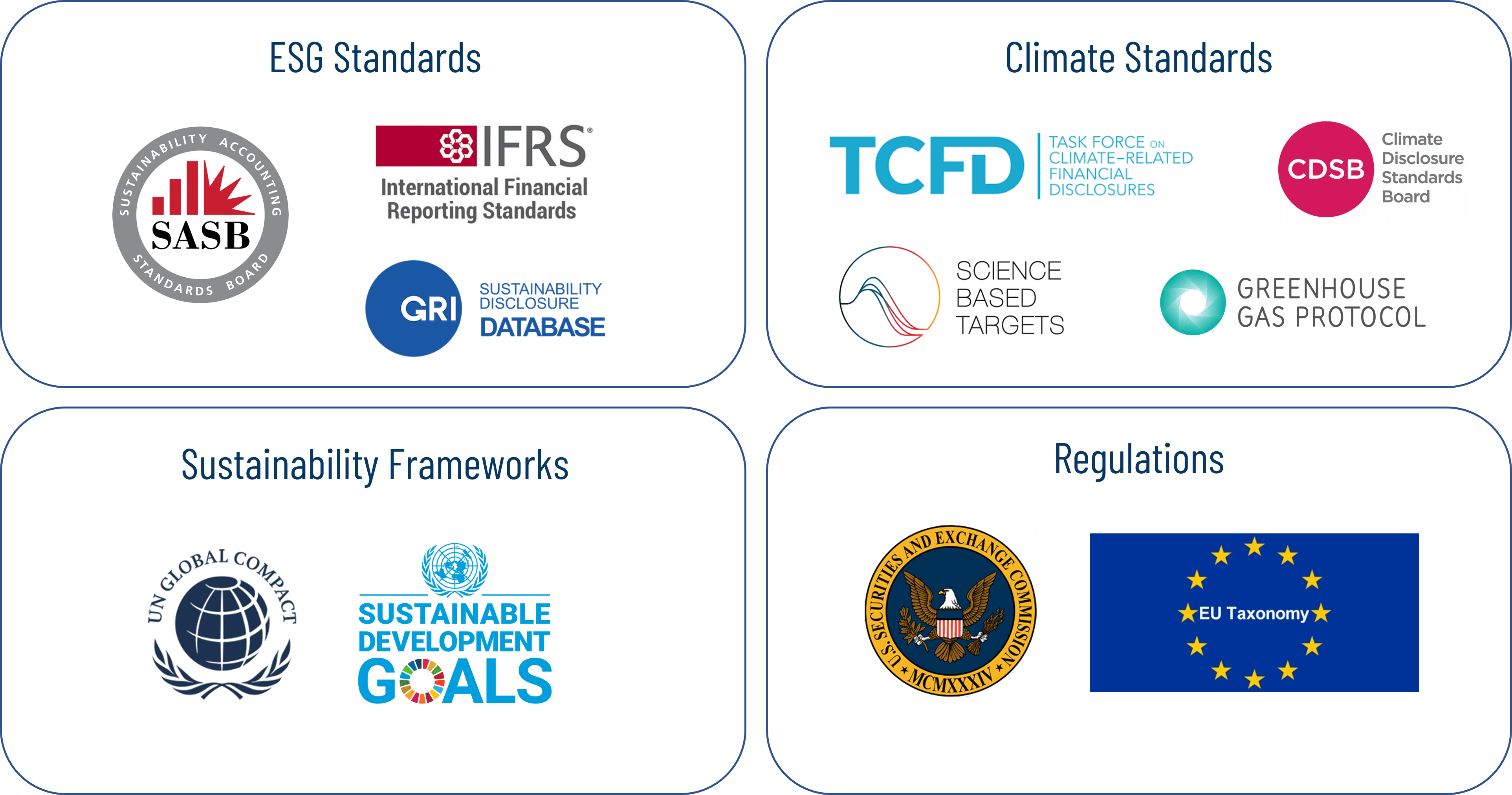
With this many variations, today ESG standards can be perceived as the Wild West. Many enterprises are establishing ESG programs that either build off prior sustainability initiatives or simply add ESG as a branch to their existing corporate governance and risk management program. Regardless of the path, bringing ESG under one umbrella with your other programs—while standardizing under a singular standard—can be a huge effort, if not managed systematically.
Regardless of the standard or framework your organization chooses to follow, you will have sector-specific guidelines to help shape what your ESG program should look like, including which items should be measured and reported in disclosures.
5) Everyone is looking to data for the answers.
In this early stage of ESG, the only expectation is for companies to show they have a plan and metrics tracking against a strategy. No specific metrics or goals to hit are currently required by a governing body, which means we’re at the lowest barrier to entry.
Part of the process of developing your ESG strategy is to identify specific metrics to track. If you’re at the beginning of your ESG process, start by reviewing the TCFD, GRI, and SASB standards and frameworks, which provide direction and lists of disclosures by industry.
_______
There are two approaches your organization can take when it comes to data and metrics.
The first is the simplest and most affordable, which is benchmarking performance against yourself.
In this approach, simply start with a baseline measurement, set goals against that level, and measure progress over time.
-
- Benefit: Besides being the easiest and least expensive, this approach only compares yourself to that which you can control.
- Con: You cannot demonstrate superiority to other companies or your competitors for an advantage.
If your organization chooses this route, start with a self-assessment similar to what you might conduct with a third-party risk assessment, only apply to your organization in ESG-specific categories.
The second approach to data and metrics is more difficult and more expensive, and it means you are directly benchmarking yourself against peers.
Attaining data for your peers can be difficult, but subscriptions to data aggregation companies can provide some of this information. This approach is typically best suited for publicly traded companies who want to show a competitive advantage, improve earnings per share (EPS), or negotiate a lower cost of capital with investment banks.
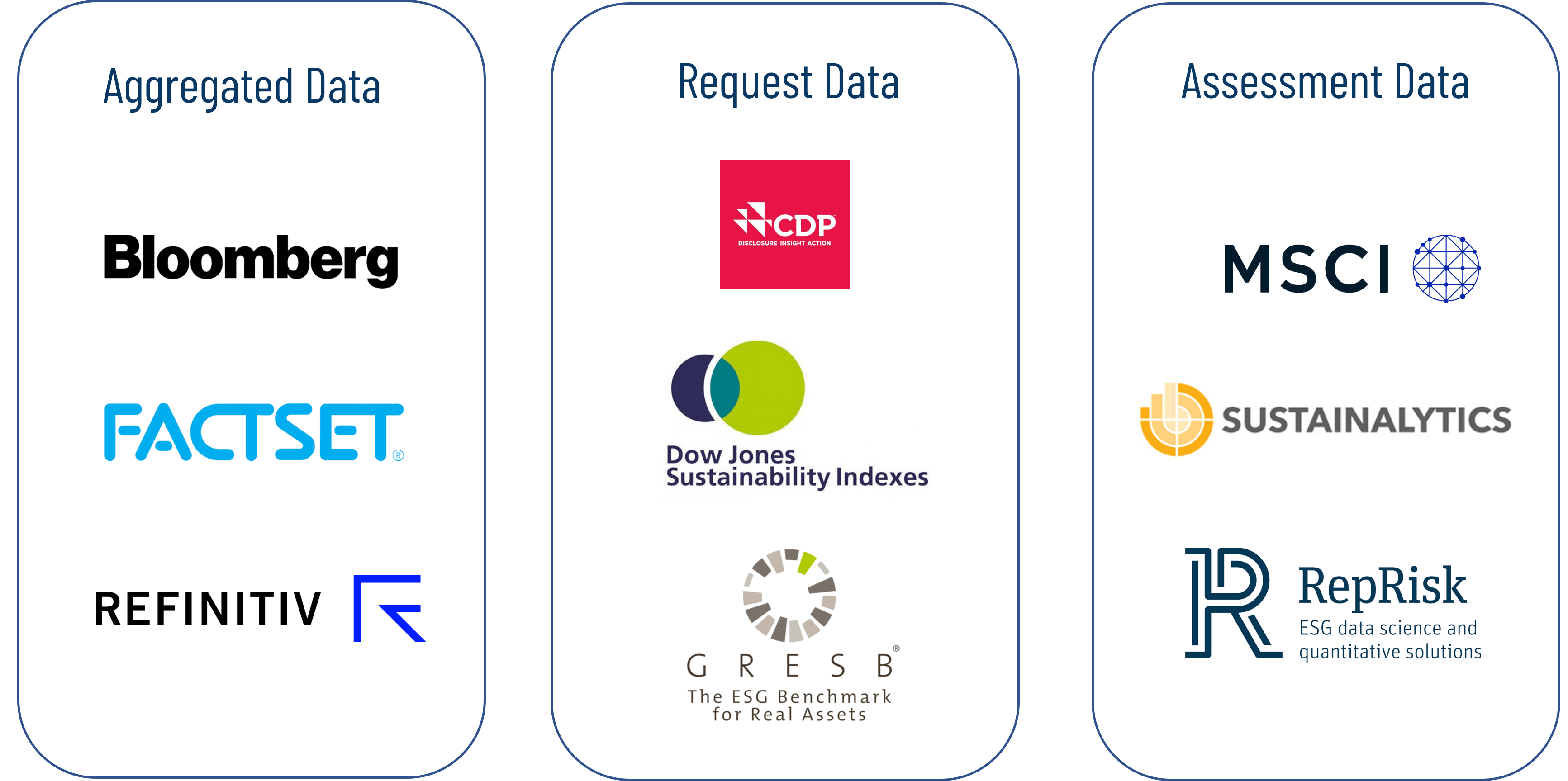
Conclusion
ESG is in-demand by stockholders and stakeholders. Business leaders of tomorrow are now required to problem-solve for ESG considerations today.
Taking a holistic approach to ESG in your organization will yield the most creative and viable new solutions.
Leaders responsible for their organization’s ESG programs say that for the first time they believe they are on the precipice of planning actions that will ultimately affect the community and the world in a positive way.
More Reading to Check Out
The G in ESG On-Demand Webinar
In this webinar, we’ll review how organizations are leveraging governance practices to document and report on their ESG goals.
How to use ESG standards to build your social strategy
Learn how to leverage the most common ESG standards and frameworks to build effective social practices in your ESG strategy.
How to use ESG standards to build your environmental strategy
Learn how to apply ESG standards and frameworks for effective environmental practices in your ESG program.

